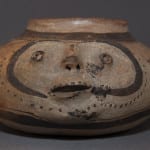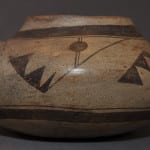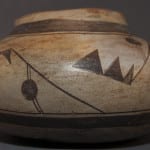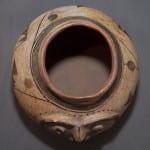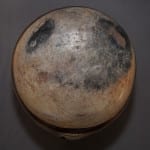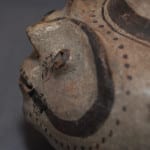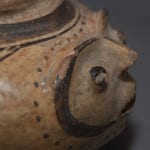Except for the red rim typical of Polacca “C” and “D” ware, the jar is monochromatic; the white slip with small crackles is also characteristic of such ware. Either the pot has been lightly varnished or there is a noticeable patina on the pot: It’s hard to tell.
Thick above thin framing lines are painted at the base of the neck above the design. Similar thin above thick lines frame the base of the design. This motif is typical of ancient Sikyatki ware and the revival of this tradition in the 1890s and later, but is not a design element generally found on Polacca ware. The use of framing lines suggests that this is a “Polacca D” pot, the transition ware before Sikyatki Revival became the predominant Hopi pottery type.
Except for the face, the design consists of five crooks composed of long lines emerging from the top or bottom thin framing line and ending with three triangles painted at right angles to this line. The triangles are progressively larger as they move away from the longer line. The crooks on either side of the face have triangles that point up; two of the remaining three crooks have downward pointing triangles so that the overall pattern has these triangles alternating direction. Each crook curls around a large dot and in four of the five cases parallel lines run through this dot connecting the closest thin framing line to the long line of the crook.
The face is applied so that the top of the head sharply juts out almost 0.5 inches from the pot surface while at the level of the eyes the face merges into the surface. However the eyes, nose, mouth and chin are also built up off the pot surface. The face is carefully constructed and painted. Forty-six dots are painted on the pot surface around the heart-shaped face, which is outlined by two crescent lines. The eyes and nose have deep indentations representing pupils and nostrils. The lips are carefully modeled with the left edge a bit higher than the right. They jut substantially off the pot surface, and enclose a mouth cavity with some depth. The overall effect is to give the face a dramatic, surprised and questioning look. The face is neither grotesque nor friendly but it is a strong image.
I have photographs of three similar pots.
The first is published in Marti Struever’s catalog Painted Perfection and may be part of her collection (2001:28). Slightly larger than jar 2012-03, the Struever pot has more color in its decoration and the decoration is more elaborate than on pot 2012-03, but the pots appear to have an identical spirit and may have been made by the same unknown potter. The caption notes that the pot was made for sale and not indigenous use.
In April 2012 two Polacca pots with raised faces were sold by Cowan’s Auction. Both have much more elaborate designs than 2012-03 and are thus more spectacular. One pot is a double-lobed canteen with a face on each lobe. Both of the Cowan’s pots seem more grotesque to me, sort of like haunting clown images. (Photographs on file.) I do not know the provenance of either pot. Both were sold as “fourth quarter of the 19th century.”
In 1892, Jesse Fewkes, leader of the Hemingway Expedition bought a collection of about 3,000 Hopi ceramics from Thomas Keam. Upon Mary Hemingway’s death in 1894 the collection was given to the Peabody Museum at Harvard, where it briefly resurfaced in the 1940s and then largely disappeared until 1976 when a comprehensive catalogue raisonne was prepared (Wade, 1981). The Keam Collection is particularly rich in Polacca ware vessels and is, I believe, by far the largest collection of such pottery in the world. While the collection contains figurative items, I find no figurative pots in the Keam collection even roughly similar to bowl 2012-03.
In the early 1900s, Richard Baxter Townsend (of England?) apparently visited Hopi where he assembled a collection of artifacts, including pottery. Much of his collection was donated to the Pitt Rivers Museum of Oxford University, either in 1903 or upon his wife’s death (after his own) in 1931. Because of a lack of photographs in the catalog, I do not know if the surface finish of the pots would qualify them as Polacca ware; the background color and color of decorating paints suggest that they are. The form of three of Townsend’s pots seem similar to jar 2012-03:
Catalog #2004.124.1: Globular bowl with grotesque face modeled in low relief on one side; rain cloud and lightening symbols on the other, painted in red, brown and black on cream ground. Two small handles at the sides, one of which is broken. Bequeathed in 1931.
Catalog #1903.36.21: Globular basin. Monstrous face with protruding tongue on one side; rain cloud and lightening on the other. Red and brown on cream. Collected in 1903.
Catalog #1931.60.14: Flask with one flat side, the other curved with ears, eyes and nose of a face shown plastically and painted. Bequeathed in 1931.
The Townsend donations to the Pitt Rivers Museum contain many Hopi figurative clay vessels. The three listed above seem closest to bowl 2012-03 based on their catalog entries. Marti Struever has visited the Pitt River Museum at Oxford and examined their collection directly. I bought jar 2012-03 from Marti. As noted below, she thinks this jar closely resembles a jar in that collection that was collected by John Wesley Powell and later given to Richard Townsend. (Marti does not have the catalog number of this pot.) I find mention of gifts from Powell to Townsend in the online catalog of the Pitt Rivers Museum, but not attached to raised-face pots, as near as I can tell. Then again, unlike Marti, I have not visited the museum storerooms.
There is no specific provenance for jar 2012-03. Perhaps Powell vacuumed up all the available raised face jars in the 1880s and later gave jar 2012-03 to Townsend, leaving none to later be collected by Thomas Keam and sold to Fewkes in 1893. Such a pattern would explain why the Keam/Fewkes/Hemmingway colection at the Peabody Museum (Harvard) does not contain any effigy pots similar to 2012-03. In a U-Tube video Marti Streuver indicaterd that she thought that this jar was “made in the 1880’s.”
Marti evaluates pot 2012-03 as follows:
A jar constructed with a face in the clay depicting eyes, nose and mouth depicted. The jar has two black framing lines plus lines around the ‘face’. The jar has a crackled slip, identified as ‘Polacca’ slip. The vessel would have been collected at Hopi in the late 1880s or early 1890s . This jar closely resembles a jar in the Pitt Rivers Museum, Oxford University. Their jar was a gift from R.B. Townsend, who received the vessel from John Wesley Powell (Bureau of American Ethnography). Powell collected pottery of this type, and with this slip, during collecting trips in the late 1800s . This vessel…dates to this period….Condition: Excellent with slight wear. No repairs or restoration. [Appraisal on file.]



